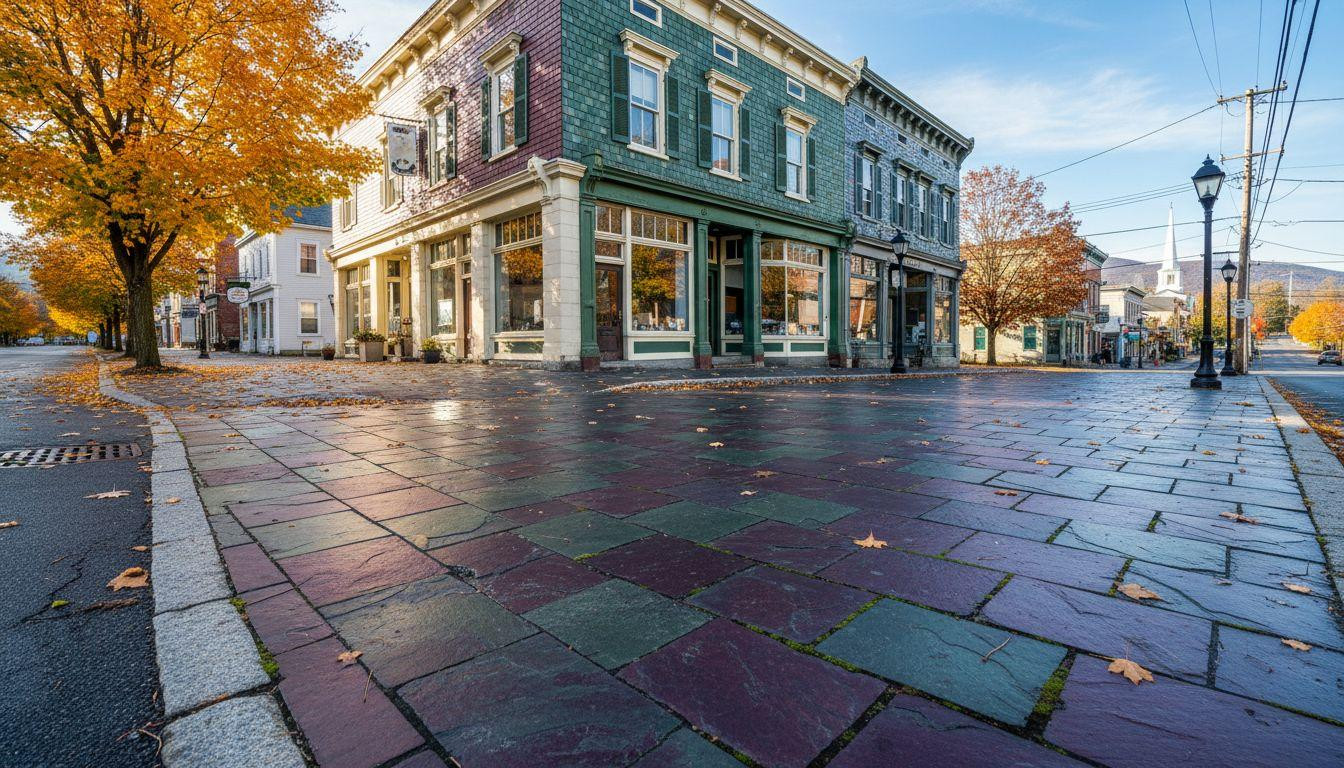Purple slate sidewalks capture the morning light in Granville, New York, revealing colors found nowhere else in America. Along Main Street, deep forest greens blend with burgundy reds. This village of 2,500 people earned the title “Colored Slate Capital of the World” through geological coincidence and Victorian ambition.
Iron-rich limestone beneath Washington County formed naturally colored stone during ancient mountain formation 440 million years ago. While neighboring quarries produced uniform gray slate, the Granville deposits contained mineral impurities. The result: purple, red, green and gray variations within individual quarry locations.
The geology that created a downtown
Granville is located 90 minutes north of Albany on deposits unique to this corner of New York State. The Taconian orogeny pushed volcanic islands against early North America. Sediments rich in iron oxides and chlorite produced color variations not found elsewhere.
During the 19th century boom, colored slate from local quarries was shipped nationwide for roofs, mantels, and monuments. Today, the same purple-green stones make up the downtown sidewalks. Victorian storefronts feature slate facades in earth tones that change with changing light.
The Slate Valley Museum (admission $7) houses samples that show the full color spectrum. Greenish-gray formations are 98 to 197 feet thick. The purple deposits extend for 39 to 49 feet and are streaked throughout with dark red veins. Through collaborative conservation efforts, these geological treasures are preserved as functional streetscapes.
128 Victorian buildings tell a story
The National Register District preserves the slate heritage
The downtown core includes 128 buildings listed on the National Register of Historic Places. Houses in the neo-Gothic style from 1850 bear witness to early slate craftsmanship. Greek Revival-style structures such as the Nathan Going House (1848) show how colored stone shaped local architecture.
The Granville Inn, built in 1925 in the Jacobethan Revival style, replaced the earlier Female College on the same site. Eastlake-style homes built in 1883 feature elaborate slate siding. Each building reflects the prosperity that colored slate mining has brought to this rural valley.
Museums preserve what streets show
The Pember Museum ($5-10 donation) contains natural history collections, including specimens of extinct species. Franklin Pember founded this institution in the late 19th century. The Slate Valley Museum explains how geological formations shaped the city's identity.
The Farmer's National Bank, a limestone and brick Romanesque building, housed the offices of the WH Hughes Slate Company. This building has served as municipal offices since 1945 and maintains the connection to the quarry heritage.
What discovery feels like here
Morning walks reveal hidden details
Between 7 and 9 a.m., the city center belongs to local coffee drinkers on their way to work. Slate sidewalks wet with dew show true colors: deep purple transitions to forest green within meters. No tour group disturbs the quiet rhythm of everyday morning life in a small town.
Victorian buildings capture soft light differently than uniform stone. Purple slate absorbs heat while green areas reflect cooler tones. Walking these empty streets feels like discovering America before tourism discovered it.
Autumn leaves meet earth tones
Late September through October brings fall colors that complement the natural slate tones. Maple red tones are reminiscent of burgundy stone. Oak stains sidewalks a warm purple. This color combination is not found anywhere else in small town America.
Hick's Orchard, 3 miles from downtown, offers apple picking with mountain views. Dwarf goats climb 6 meter high ramps in their playground. Apple cider donuts and freshly squeezed juice provide authentic rural experiences without commercial packaging.
The peace you can't find in Saratoga
Thirty miles south, Saratoga Springs welcomes 28,000 residents and millions of visitors to the resort town's amenities. Hotel rooms cost $200-$400 per night in high season. Racing season brings with it crowds that flood Victorian streets designed for smaller populations.
Granville offers the opposite experience: Victorian architecture for $70-150 a night, slate culture without the crowds in gift shops, and authentic small-town rhythms. The Mettowee River trails remain empty even during the fall foliage season. This destination does not compete with larger cities. It offers alternatives for travelers seeking cultural heritage on a human scale.
Answers to your questions about Granville's colored slate capital
When should I visit the city to have the best experience?
Summer through early fall (June-October) offers mild temperatures and extensive seasonal activities. October delivers top foliage in natural slate colors. Winter brings snow-covered Victorian streets but limited services and shorter daylight hours.
What makes Granville's slate scientifically unique?
Geological formations containing iron oxides and chlorite resulted in natural color variations. Most American slate appears uniformly gray or green. Only the Granville deposits produce purple, red, and multicolor combinations within individual quarry locations. The Taconian orogeny 440 million years ago created these unique mineral combinations.
How does this compare to other heritage cities?
Unlike Williamsburg or Sturbridge Village, Granville is neither a recreation center nor a museum. It is a working community where 2,500 residents maintain Victorian buildings as homes and businesses. Cultural heritage is lived here and not performed for visitors.
The light of dawn touches the purple slate one last time before full sunrise. Victorian cornices capture shadows that change from green to burgundy. Granville preserves America's colored stone capital through everyday use, not museum display.
